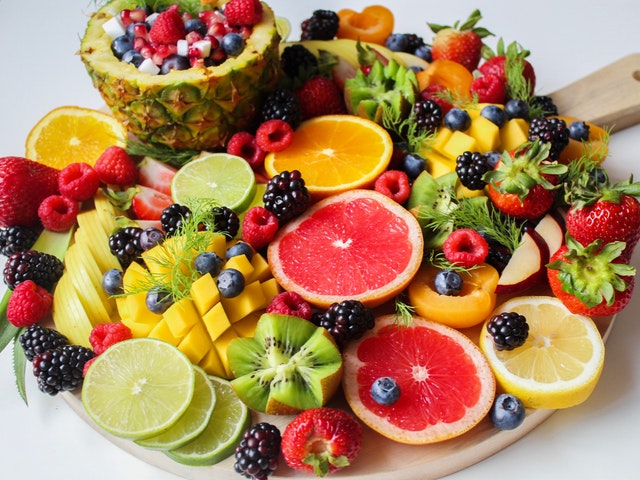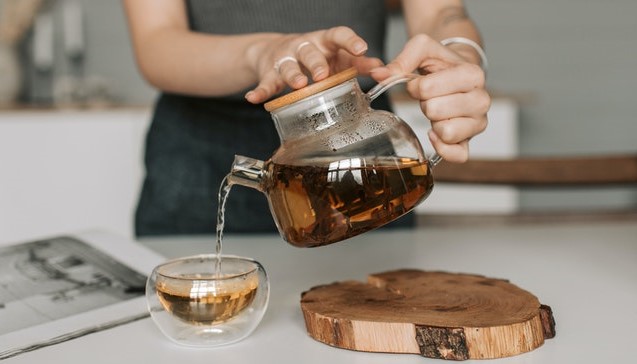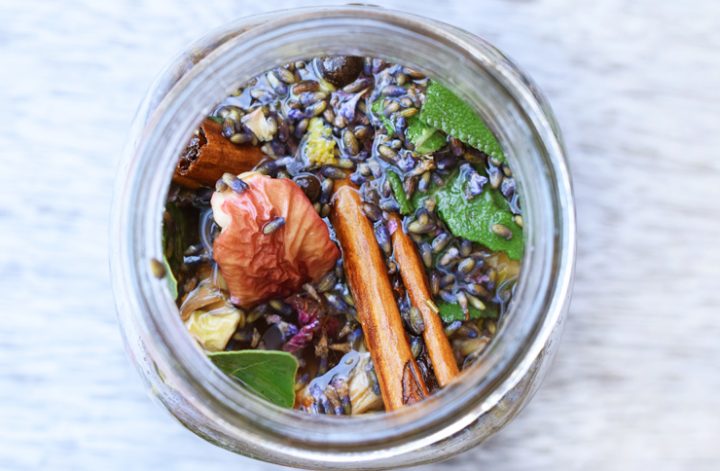Photo: Spencer Davis
When the world outside starts to feel overwhelming, head to this stress toolkit here and download my Recipe for Daily Bliss! Yep, there’s a recipe in this one that you can follow step by step and it contains my top 12 ways to reduce stress and anxiety and live a calm and connected life. From the way you take your next breath to where to put your feet in the morning, to what foods and drinks to avoid and more…. This is ‘Stress Less 101’. We are living in interesting times my friends! Take a moment from your day to inspire calm….
As I sit down to write this, the wind outside on this winter’s morning has worked itself into a mild storm. In a way, it reflects what’s happening in the world today with so much chaos and change, and the sound of that ancient Chinese curse “may you live in interesting times” is reverberating around in my head. I hear over 10,000 papers have been published to date on the mental health toll this pandemic is exerting on us. Looking after ourselves spiritually, emotionally and psychologically has never been more important.
If you’re finding life challenging now, I feel you! I’m a sensitive soul and strongly vata in my constitution and I feel like I’m out there in the wind, being tossed around, totally out of my comfort zone. So let’s make a choice now to go inside (literally and metaphorically), put on some calming music and sit down with a warm cup of tea. I want to share some of the calming techniques I’ve learnt over the years with you. Here are my top 12 easy (so easy you can do them right now), free (yep! Won’t cost you a cent) and self-loving ways to relieve anxiety and stress. Initially I thought I’d put all 12 into one post, but it got very lengthy once I incorporated research so I’ll start with the first 6 and the next 6 will follow in part 2. Okay, let’s get started.
1. Breathe with your belly

Photo: Engin Akyurt
The practice of belly breathing goes back thousands of years and is an important component of Yoga and Tai Chi. It lowers both physiological and psychological stress levels and it’s a simp
le and easy tool you can use anytime you feel stressed or tense. Belly breathing requires the breather (you) to focus on breathing deeply and expanding the lungs downwards into the diaphragm rather than relying on the upper chest alone for breathing. Where’s your diaphragm? It’s the large muscle at the base of your lungs and it moves up and down as you breathe to assist with inspiration and expiration of air.
The problem with only using upper chest breathing is that you end up spending most of your waking breaths in a form of shallow breathing, which increases or sustains anxiety. Deep belly breathing instead slows the respiratory rate, pulse rate and lowers blood pressure (basically everything that happens when we relax).
This is all about breathing fully and with intention. By consciously engaging your diaphragm when you breathe, you’ll experience numerous benefits instantly! A 2019 systematic review on belly breathing (also called ‘diaphragmatic breathing’) demonstrated multiple mind-body benefits including:
- Significantly reduced cortisol levels
- Improved respiratory rate
- Reduced sympathetic state (vigilance, nervous agitation)
- Improved DASS (Depression Anxiety Stress Scales) scores
- Sustained attention
- Improved mood
- Reduced blood pressure and heart rate
And one other thing to consider is it’s worth getting nice and comfortable with the idea of breathing to let your belly truly relax and just hang out. We get so attached to a flat stomach with all the media pressure and unrealistic female body images and it’s not helping our stress levels. Actively holding the stomach in causes shallow breathing which increases nervous tension in the long run.
To deep belly breathe, find a comfortable place to sit or lie and place a hand on your lower abdomen (belly). Place the other hand on your chest. Breathe in deeply through your nose, sending the breath down into your belly so that the hand on your belly is lifted as your belly expands. Then breathe out through your mouth, slowly. Breathe out all the air before taking in your next breath. Repeat 5 times, then luxuriate in the calm.
We have a tendency to shallow breathe with our chest when stressed or under pressure. So look out for movement in the chest when breathing in. the hand on your chest shouldn’t move. Over time, you’ll find it easier to breathe with your belly without involving the chest.
Try using belly breathing with my CALM meditation below.
15 minute guided meditation for calm and inner peace
2. shhh…..listen……

Photo: Felix Mittermeier
The calming and meditative practice of deep listening known as ‘Dadirri’ is Aboriginal in origin. It induces a state of calm presence and self-awareness. Think about it as generating the qualities of deep silence, contemplation and reflectivity within you, while maintaining a relationship of reverence with the nature we hold so sacred.
This practice particularly suits nature-lovers and those who find solace and peace in nature. It’s creates a sense of aliveness to everything in your biosphere in such a poetic and timeless way. In the moment it becomes clear just how precious this planet is and how every moment is a possibility to more deeply appreciate earth and all her creatures.
According to Miriam Rose Baumann, “It’s about, I suppose, the make-up of who Aboriginal people are and it’s about belonging as well … and just continuously making yourself aware of where you’ve come from, why you are here, where are you going now and where you belong…You have to look into yourself and find that spirit, there’s a spring within you, within me….The spring that I talk about is your make-up.”
“To be still brings peace – and it brings understanding. When we are really still in the bush, we concentrate. We are aware of the anthills and the turtles and the water lillies.” (Miriam Rose Baumann, 2017)
Create a Dadirri practice by taking yourself into nature, somewhere quiet and away from the noise of daily life. Find somewhere comfortable to sit, and become aware of your breath as you take in the sounds of the world around you. Gradually become more in tune with the environment. Similar to Forest bathing, and to the shamanic practice of Hamutay, this is all about listening and merging with nature. Surrender to just being. Listen to the birds, the breeze, the tiny and large sounds around you with gentle presence. If you can manage 15 – 30 minutes, you’ll find yourself in a clear-headed state of calm afterwards.
Audio Interview: Dadirri and healing: A yarn with Dr Miriam-Rose Ungunmerr-Baumann
3. Try a Nature Bath

Photo: Tobi
We have a lot of trees in Australia. Can you think of some near you? Perhaps they’re in your backyard? The local park? The local cycle or walking track? Wherever you are, there’s bound to be somewhere you can just drift aimlessly for 15 minutes. And that pretty much sums up the Japanese art of Forest Bathing. Here’s why you should try it…
A comparative 2019 study of the effects of forest bathing ‘Shinrin-yoku’ on 155 participants found that this immersive experience significantly reduced blood pressure and improved mood in all participants with greater positive effects seen in those with depressive tendencies. Not surprising considering this totally easy and free approach to stress-relief will consistently slow you down and bring you into a deeply relaxing state of connection with nature. It’s a popular relaxation practice in Japan, Korea, Europe and the USA.
A systematic review published the same year noted numerous physiological benefits with forest bathing, namely:
- Reduced anxiety and depression
- Improved sleep
- Improved cardiovascular health
- Increased antioxidant activity
- Improved metabolic function
- Improved immune function
- Lifted emotional state and reduced anger
- Reduced cortisol (stress hormone) levels
- Increased positivity in attitude and perception
- Increased ability to adapt and recover psychologically
Create your own version of Shinrin-yoku by heading outdoors to bathe in your local trees or bushland. Although it’s ideal to do this with someone (note: ‘no chatting while bathing’ rule), if you’re on your own you might want to take your mobile phone – especially if you’re wandering in Aussie bush. Just turn it on silent so it doesn’t distract you. And there’s a ‘no photos’ rule here too!
Once you’re there, tune into how you’re feeling and begin to wander softly, pausing now and then to look more closely at the nature that surrounds you. A leaf, a tree, some moss on a rock. Find somewhere to sit comfortably and being deep listening to the sounds of nature. Spend at least 15 – 20 minutes in your forest bathing experience. So peaceful.
4. Ditch the Sugar

Photo: Trang Doan
…because sugar causes stress. I know it’s not easy! But there are so many great reasons to remove refined sugar from your diet. There are still lots of good and natural sugars around like all those delicious fruits above. It’s just the ones that come in highly processed, sweetened and refined forms that you want to give the flick. Muesli bars, cereals, sweets, chocolate, cakes, soft drinks… Let me tell you why.
- Sugar reduces our ability to cope with stress. A 2016 study observed that the intake of sugary drinks has a similar effect in the brain to early life stress and trauma (such as a shrinking hippocampus and reducing nerve growth). Nerve development and growth is needed to synthesise all those feel-good chemicals in our brain essential for stress response. Try producing serotonin, opioids and dopamine without nerve cells. Sugar also reduces our ability to recover from stressful situations by reducing cortisol binding and activity. Time to ditch the Cola.
- Sugar worsens anxiety and depression. A 2019 meta-analysis showed that sugar has no affect on mood at all, despite our tendencies to believe that sugar is a ‘pick-me-up’. In fact, refined sugars are more likely to cause brain fog and fatigue within 30 minutes of consumption. Stress, anxiety, fear, addiction and depression are among the emotional states associated with high sugar intake. Sugar rush? More like sugar crash.
- Addiction. According to a 2019 study “Sucrose consumption activates the mesocorticolimbic system in a manner synonymous with substances of abuse.” In simple terms, sugar works on the dopamine pathways just like cannabis and cocaine, and it triggers addictions. Over time, a diet high in refined sugars leads to physiological and neurobiological changes in the brain that change our emotional processing and influence our behaviours to make us more impulsive. A 2019 meta-analysis also found that two sugar-sweetened drinks daily is enough to increase your risk for depression.
- Sugar causes weight gain and obesity. The WHO estimates 39% of the global adult population is overweight while around 65% of Australian adults are overweight. This is directly linked to high fat and sugar dietary intakes. Studies show that long term sugar consumption increases the impulse to feed, reducing our control over-eating patterns.
Start eradicating refined sugars from your diet by including a range of nutritious foods and drinks into your day. Things like berries, smoothies, decadent chai lattes naturally sweetened with date powder, and anything that in its natural state is red, green, blue or orange. I’m talking carrots and blueberries of course. Herbal teas can help reduce sugar cravings if needed. Try licorice root, rooibos, orange peel, peppermint, chamomile, cinnamon or aniseed.
5. Discover your Mantra

Love my mala beads. The vibrations of many sounds live in them. Photo: Sulin Sze
The ancient practice of repeatedly chanting a word or phrase (internally or out loud) has so much to offer us in our modern world because it offers a calming respite from the stimulating, stressful and highly distractive environment we operate in on a daily basis. There’s a lot of noise running in the background of our worlds. We try to remain passively detached from these (internal and external) noises while repeating any mantras.
Initially, mantras were seen as ‘protecting from misery’, so you see them feature mainly in Eastern spirituality, however, any word can be a mantra. Any phrase. Any wish or desire, can be a mantra, manifesting and transforming with your every breath. It’s all about recognising the power of sound and what it can manifest for you. “This science when put to practice removes all the obstacles to growth, rids all miseries, raises a sādhaka or practitioner in wisdom, and catalyzes the process of realizing and achieving the goals set forth for and by every Spiritual being in a human form.” (Parthasarathi, 2017)
Words are sacred. Words are verbal formulas imbibed with power. Words are powerful. Think about the words “I love you”. Imagine hearing that said to you over a hundred times in succession and how you’d feel. Maybe that should be our mantra to ourselves…
Often mantras are associated with deities and have a strong spiritual basis. Most of us have heard the Sanksrit sound “Om” (AUM), often chanted as a mantra. Mantra words and sounds were used in ancient Greece, India, China, Japan and associated with gods and goddesses and their gifts as a spiritual practice. You can also approach the practice of mantras in a meditative way. Use the sound to draw your attention inwards for instance. Not necessarily seeking enchantment or tantric enlightenment. Just a way to self-connect.
What does the evidence say about mantra meditation?
There’s lots of positive research showing the benefits of mantras as:
- reducing stress
- reducing cortisol
- improving creative problem solving
- creating optimism
- finding meaning in life
- lowering blood pressure
- slowing breath rate
- increasing brain oxygen saturation
- activating the parasympathetics nervous system and all the spiritual care that anti-anxiety drugs don’t afford. Excited?
How to choose your mantra
Research shows that whether you choose a mantra with a spiritual basis or not, the use of a mantra enhances spiritual health. So aim to find words or sounds that carry meaning for you, and ideally they should comfort you when you hear and speak them. The preferable position for mantras is seated comfortably, and begin noticing your breath, softening your belly and getting into a rhythmic breath before you begin to chant. 10 – 20 minutes is an ideal time to practice mantra chanting. If you’re keen to take mantra further, you’ll possibly end up doing 3 cycles of 108 repetitions of your mantra or sound with mala beads, like the ones above.
I won’t recommend specific mantras. Everyone has their own needs and processes. But in terms of research, there’s lots of promising evidence on the Gayatri mantra. This is one of the most ancient divine Vedic hymns and associated with the attainment of self-realisation that underpins Vedic philosophy. A 2018 study showed a roaring success in the reduction of anxiety in the elderly using the Gayatri mantra. There was a small participant number though. A 2020 controlled trial in young athletes (2020) revealed the use of the Gayatri mantra with meditation improved attention, mental state, memory and reduced anxiety. In fact, anxiety seems to be the most significantly reduced symptom in most clinical research on the benefits of mantra meditation.
Gayatri mantra
Om Bhur Bhuvah Svaha
Tat Savitur Varenyam
Bhargo Devasya Diimahi
Diyoyonah Prachodayatt
For more information on the Gayatri mantra head to https://chopra.com/articles/the-gayatri-mantra-for-enlightenment
6. Drink your Chamomile tea

Chamomile tea. Photo: Vlada Karpovich
Chamomile (Matricaria chamomilla) is an anxiolytic (anxiety-reducing) medicinal plant. It originated from the Mediterranean and Near and Middle East. Herbalists use it to calm digestion, soothe the mind, reduce insomnia and specifically as a calming agent for children with anxiety or hyperactivity. Chamomile flowers contain volatile oil, phenolic compounds, polysaccharides and terpenoids, and they’re also rich in the calming minerals calcium and magnesium.
Therapeutic actions of Chamomile include reducing inflammation, acting as an antioxidant, fighting pathogenic infections and sedating as well as calming and enhancing digestion. In clinic I mainly use Chamomile to:
- Improve tolerance of everyday stress
- Decrease feelings of hyper-sensitivity to stress
- Improve digestive function and reduce symptoms like bloating, flatulence and abdominal pain
- Assist with sleep improvements
Chamomile is my go-to tea when I need to calm down, which is why it’s in here!
What the evidence says
Numerous studies on the effects of Chamomile on generalised anxiety disorder (GAD) show marked improvements in anxiety symptoms, and some even show weight loss. A 2020 systematic review and meta-analysis revealed statistically significant (i.e you can be very sure the effects weren’t caused by anything but the Chamomile) improvements in sleep quality and generalised anxiety scores after ingestion of Chamomile for 2 to 4 weeks. If you’re one of those adrenal types then take note, a 2018 study found that in as little as 3 days, Chamomile improved the cortisol slope to better naturalise cortisol release from morning to night leading to a reduction in anxiety symptoms.
Not totally related to anxiety, but an added benefit of Chamomile is that it significantly decreases blood glucose and cholesterol levels. As recent research shows, it may be useful in preventing chronic conditions like diabetes mellitus (which has a strong causative stress factor). It works on the Nrf2 pathway exerting antioxidant effects and reducing the oxidative stress caused by metabolic conditions featuring obesity or diabetes.
How to take your Chamomile
The adult daily dose of Chamomile for a therapeutic effect is 6-12g dried flowers. Your average teabag gives you a couple of grams so you may need a few cups! Pop the herbs into your cup, pour on hot water and cover for 15-30 minutes, allowing the herb to infuse. You might want to add honey, Chamomile has strong bitter notes which isn’t surprising considering the volatile oils it contains and the phenols.
I recommend Chamomile as an anytime of the day herb, but if you have trouble sleeping, try it before bed. If you have more general anxiety, it’s great as a morning cuppa. I like it as a latte as well, using almond milk, cinnamon and honey. For more ideas on how to take your infusion making to the next level, head to the Wild Medicine Academy and see my webinar (complete with recipe book) ‘The Art of the Infusion’.
*Chamomile isn’t suitable for anyone with a Daisy (Asteraceae) family allergy.
Daily Recipe for inner CALM
Ingredients
- 1+ willing participant (that's you)
- 1 Access to an area with trees
- 1 Somewhere comfortable to sit or lie down
Instructions
- Deep Belly Breathing on Waking: Set your morning alarm 10 minutes early and spend that time in bed practicing your belly breathing. You can listen to my CALM meditation(or just to silence if you prefer). When you’re finished, you’ll be nice and calm to start the day.
- Dadirri. Tread the earth (grass,sand, soil) first thing in the morning for a few minutes. Do in your pj's if you like. Spend 15minutes practicing Dadirri (deep listening). Sit in your garden or somewhere in nature in silence while you listen to the sounds of nature. This will generate a greater capacity for inner silence and attunement.
- Forest Bathe: At some point in the day, head out for a walk in nature. This could be your daily Forest/Bush/Tree bath .... or just some way that you can immerse yourself in nature and wash away all the stress. Perfect for lunchtime or late afternoon when our energy tends to naturally dip. You might also like dance, yoga, shaking or other movement practices like Tai Chi.
- Throughout the day: Commit to removing refined sugars from your diet today. Nothing artifically sweetened! No sweets, chocolate or soft drinks.
- Sit comfortably for 10-20minutes, find a slow, rhythmic breath and repeat your mantra 108 times. Whenfinished, remain in stillness for 5 minutes and feel the vibrations of themantra permeate within you.
- Make a cup of Chamomile tea using 6g dried flowers in 250mL hot water. Sit back and sip yourself into bliss.
I hope you like this recipe for calm. If you can do them all, fantastic! Otherwise, feel free to adapt it or choose to prioritise the things you like. These are the first 6 of 12 steps, so stay tuned for the next 6! I’d love to hear what worked for you, or how you personalised any of these steps. Feel free to add a comment below anytime ( ๑‾◡‾́)


Hey there! Welcome to my world of totally natural and powerful healing medicines. Medicines from nature. Medicine from Source. I’m a naturopath and herbalist with extensive clinical experience working with a range of health conditions including hormonal, metabolic, mental health, sleep and more.
I’ve brought together years of clinical and teaching experience, academic skill and curiosity to bring you this blog. I hope you enjoy it! If you do, leave a comment, I’d love to hear from you!

References
- Furuyashiki, A., Tabuchi, K., Norikoshi, K., Kobayashi, T., & Oriyama, S. (2019). A comparative study of the physiological and psychological effects of forest bathing (Shinrin-yoku) on working age people with and without depressive tendencies. Environmental health and preventive medicine, 24(1), 1-11.
- Wen, Y., Yan, Q., Pan, Y., Gu, X., & Liu, Y. (2019). Medical empirical research on forest bathing (Shinrin-yoku): A systematic review. Environmental health and preventive medicine, 24(1), 1-21.
- Ungunmerr, M. R. (2017). To be listened to in her teaching: Dadirri: Inner deep listening and quiet still awareness. EarthSong Journal: Perspectives in Ecology, Spirituality and Education, 3(4), 14-15.
- https://www.abc.net.au/news/2017-08-12/using-aboriginal-meditation-to-improve-improve-mental-health/8799278
- Hopper, S. I., Murray, S. L., Ferrara, L. R., & Singleton, J. K. (2019). Effectiveness of diaphragmatic breathing for reducing physiological and psychological stress in adults: a quantitative systematic review. JBI Evidence Synthesis, 17(9), 1855-1876.
- Ma, X., Yue, Z. Q., Gong, Z. Q., Zhang, H., Duan, N. Y., Shi, Y. T., … & Li, Y. F. (2017). The effect of diaphragmatic breathing on attention, negative affect and stress in healthy adults. Frontiers in psychology, 8, 874.
- Jacques, A., Chaaya, N., Beecher, K., Ali, S. A., Belmer, A., & Bartlett, S. (2019). The impact of sugar consumption on stress driven, emotional and addictive behaviors. Neuroscience & Biobehavioral Reviews, 103, 178-199.
- Dias, J. P., Joseph, J. J., Kluwe, B., Zhao, S., Shardell, M., Seeman, T., … & Golden, S. H. (2020). The longitudinal association of changes in diurnal cortisol features with fasting glucose: MESA. Psychoneuroendocrinology, 119, 104698.
- Maniam, J., Antoniadis, C. P., Youngson, N. A., Sinha, J. K., & Morris, M. J. (2016). Sugar consumption produces effects similar to early life stress exposure on hippocampal markers of neurogenesis and stress response. Frontiers in molecular neuroscience, 8, 86.
- Mantantzis, K., Schlaghecken, F., Sünram-Lea, S. I., & Maylor, E. A. (2019). Sugar rush or sugar crash? A meta-analysis of carbohydrate effects on mood. Neuroscience & Biobehavioral Reviews, 101, 45-67.
- Bloomfield, M. A., Ashok, A. H., Volkow, N. D., & Howes, O. D. (2016). The effects of Δ 9-tetrahydrocannabinol on the dopamine system. Nature, 539(7629), 369-377.
- Miller, C., Ettridge, K., Wakefield, M., Pettigrew, S., Coveney, J., Roder, D., … & Dono, J. (2020). Consumption of sugar-sweetened beverages, juice, artificially-sweetened soda and bottled water: An Australian population study. Nutrients, 12(3), 817.
- Hu, D., Cheng, L., & Jiang, W. (2019). Sugar-sweetened beverages consumption and the risk of depression: A meta-analysis of observational studies. Journal of affective disorders, 245, 348-355.
- Knüppel, A., Shipley, M. J., Llewellyn, C. H., & Brunner, E. J. (2017). Sugar intake from sweet food and beverages, common mental disorder and depression: prospective findings from the Whitehall II study. Scientific reports, 7(1), 1-10.
- Parthasarathi, S. K. (2020). Ancient science of mantras–Wisdom of the sages. International Journal of Yoga, 13(1), 84.
- Burchett, P. E. (2008). The ‘magical’language of mantra. Journal of the American Academy of Religion, 76(4), 807-843.
- Lopez Jr, D. S. (1990). Inscribing the Bodhisattva’s speech: On the” Heart Sūtra’s” mantra. History of religions, 29(4), 351-372.
- Candrawati, S. A. K., Dwidiyanti, M., & Widyastuti, R. H. (2018). Effects of mindfulness with Gayatri Mantra on decreasing anxiety in the elderly. Holistic Nursing and Health Science, 1(1), 35-45.
- Samajdar, S. S., & Mukherjee, S. (2020). Effect of Gayatri Mantra Chanting on Attention, Memory, Anxiety and Mental State in Young Athletes: A Prospective Study. International Journal of Current Research in Physiology and Pharmacology (IJCRPP), 5-7.
- Lynch, J., Prihodova, L., Dunne, P. J., Carroll, A., Walsh, C., McMahon, G., & White, B. (2018). Mantra meditation for mental health in the general population: A systematic review. European Journal of Integrative Medicine, 23, 101-108.
- Chan, R. R. (2014). Mantra meditation as a bedside spiritual intervention. Medsurg Nursing, 23(2), 84-88.
- Staples, J. K. The Science of Mantra. Science for the Yoga Therapist.
- Hajizadeh-Sharafabad, F., Varshosaz, P., Jafari-Vayghan, H., Alizadeh, M., & Maleki, V. (2020). Chamomile (Matricaria recutita L.) and diabetes mellitus, current knowledge and the way forward: A systematic review. Complementary therapies in medicine, 48, 102284.
- Amsterdam, J. D., Li, Y., Soeller, I., Rockwell, K., Mao, J. J., & Shults, J. (2009). A randomized, double-blind, placebo-controlled trial of oral Matricaria recutita (chamomile) extract therapy of generalized anxiety disorder. Journal of clinical psychopharmacology, 29(4), 378.
- Mao, J. J., Xie, S. X., Keefe, J. R., Soeller, I., Li, Q. S., & Amsterdam, J. D. (2016). Long-term chamomile (Matricaria chamomilla L.) treatment for generalized anxiety disorder: A randomized clinical trial. Phytomedicine, 23(14), 1735-1742.
- Hieu, T. H., Dibas, M., Surya Dila, K. A., Sherif, N. A., Hashmi, M. U., Mahmoud, M., … & Huy, N. T. (2019). Therapeutic efficacy and safety of chamomile for state anxiety, generalized anxiety disorder, insomnia, and sleep quality: A systematic review and meta‐analysis of randomized trials and quasi‐randomized trials. Phytotherapy Research, 33(6), 1604-1615.
- Keefe, J. R., Guo, W., Li, Q. S., Amsterdam, J. D., & Mao, J. J. (2018). An exploratory study of salivary cortisol changes during chamomile extract therapy of moderate to severe generalized anxiety disorder. Journal of psychiatric research, 96, 189-195.
- Bayliak, M. M., Dmytriv, T. R., Melnychuk, A. V., Strilets, N. V., Storey, K. B., & Lushchak, V. I. (2021). Chamomile as a potential remedy for obesity and metabolic syndrome. EXCLI Journal, 20, 1261-1286.





